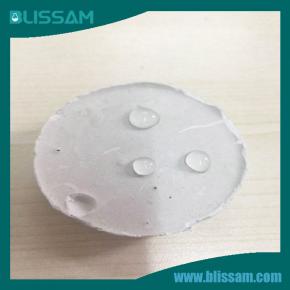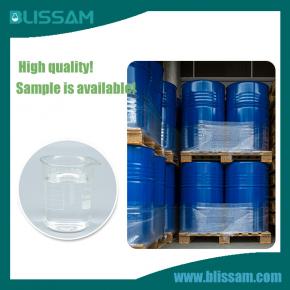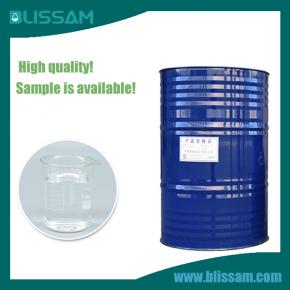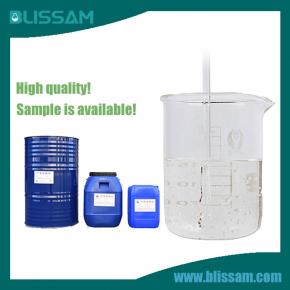BLISSAM product line includes silicone fluids for medical and pharmaceutical purposes, as well as for industrial and consumer use. Our medical-grade silicone fluids are specially designed for use in medical devices, drug delivery systems, and surgical coatings. They are safe, non-toxic, and biocompatible, making them ideal for medical applications. In the industrial sector, our silicone fluids are used in a variety of applications such as lubricants, hydraulic fluids, and heat transfer fluids. They provide excellent thermal stability, chemical resistance, and low volatility, making them an ideal choice for harsh operating environments. Additionally, our consumer-grade silicone fluids can be found in household products such as shampoos, conditioners, and cosmetics, providing users with silky smooth and glossy results.
One of our most popular products is our silicone oil, which serves as an excellent lubricant for machinery and equipment. It has a high thermal stability and a wide operating temperature range, making it ideal for use in extreme conditions. Our silicone oil is also commonly used in the automotive industry, where it helps reduce engine wear and improve fuel efficiency. At Silicone Fluids, we are dedicated to providing our customers with the best silicone solutions. We have a team of experienced professionals who are committed to quality and continuously work towards improving our products and services. With our state-of-the-art manufacturing facilities and stringent quality control standards, we can ensure that our silicone fluids meet the highest industry standards.
In addition to our diverse range of products, we also offer custom formulations and packaging options to meet the specific needs of our customers. Our efficient distribution network enables us to supply our products to customers worldwide, ensuring timely delivery and excellent customer satisfaction. As a company, we are also committed to sustainability and environmental responsibility. We follow strict environmental policies and practices in our production processes to minimize our carbon footprint and promote sustainable practices.

Silicone Fluids are versatile and highly functional products that have taken the market by storm. These silicone-based compounds offer superior resilience, excellent lubrication, and an impressive temperature range, making them suitable for a wide range of applications. Whether used in industrial settings, personal care products, or as a sealant, Silicone Fluids offer exceptional performance and durability. With their unique properties, they offer unmatched protection against moisture, heat, and chemical corrosion. These premium products provide a high-quality solution for all your fluid needs. Choose Silicone Fluids for reliable and long-lasting performance in any environment.
Introducing our range of Silicone Fluids - the revolutionary solution for all your lubrication needs. Made with advanced silicone technology, our Silicone Fluids provide unmatched performance and durability for a wide range of applications. From industrial machinery to automotive, our products offer superior lubrication, reducing friction, and extending the lifespan of your equipment. With a wide temperature range and exceptional resistance to heat, moisture, and chemical exposure, our Silicone Fluids are the perfect choice for demanding environments. Trust in our Silicone Fluids to keep your operations running smoothly and efficiently.

Silicone fluids, also known as silicone oils, are a type of synthetic polymer fluid that is commonly used in various industries due to its unique properties. These fluids are composed mainly of silicon atoms and oxygen atoms, giving them a characteristic flexibility and heat resistance. They are available in a wide range of viscosities, making them suitable for a variety of applications including lubrication, release agents, and coatings. With their low surface tension and non-toxic nature, silicone fluids are also commonly used in the cosmetic and personal care industry. In addition, they are highly stable and have excellent electrical insulation properties, making them suitable for use in electronic devices. Overall, silicone fluids offer a versatile and efficient solution for many different industries and applications.
1.What role do silicone fluids play in the manufacturing of textiles and fabrics?
2.What techniques are used to analyze and measure the different physical and chemical properties of silicone fluids?
3.How are silicone fluids used in the production of paints and coatings?
4.How are silicone fluids used as coatings and inks in the printing industry?
5.What are the chemical reactions and processes involved in the production of silicone fluids?
6.What measures are taken to prevent contamination of silicone fluids during the manufacturing process?
7.How do manufacturers ensure the quality and purity of silicone fluids in various industries?
8.Can silicone fluids be recycled or disposed of safely?
9.How does the addition of silicone fluids enhance the performance of cosmetics and skincare products?
1.What role do silicone fluids play in the manufacturing of textiles and fabrics?
Silicone fluids, also known as silicone oils, are commonly used in the manufacturing of textiles and fabrics for their various properties and benefits. Some of the roles they play include: 1. Lubrication: Silicone fluids have a low surface tension and high lubricity, making them ideal for lubricating textile fibers during the spinning and weaving processes. This helps to reduce friction and prevent damage to the fibers, resulting in smoother and stronger fabrics. 2. Softening: Silicone fluids have a soft and silky feel, making them popular for use as fabric softeners. They can be applied to fabrics during the finishing process to improve their softness and drape, making them more comfortable to wear. 3. Water repellency: Silicone fluids have excellent water repellent properties, making them useful for treating fabrics to make them water-resistant. This is particularly beneficial for outdoor and performance fabrics, as it helps to keep the wearer dry and comfortable. 4. Anti-static properties: Silicone fluids have a high surface resistivity, which makes them effective in reducing static electricity in fabrics. This is especially important for synthetic fabrics, which tend to generate static electricity. 5. Heat resistance: Silicone fluids have a high thermal stability, making them suitable for use in high-temperature processes such as dyeing and finishing. They can withstand temperatures up to 200°C without degrading, making them ideal for use in textile manufacturing. 6. Dyeing and printing: Silicone fluids are often used as carriers for dyes and pigments in textile dyeing and printing processes. They help to evenly distribute the color and improve the color fastness of the fabric. 7. Anti-foaming agent: Silicone fluids are also used as anti-foaming agents in textile processing. They help to prevent the formation of foam during various stages of production, which can interfere with the quality of the fabric. Overall, silicone fluids play a crucial role in the manufacturing of textiles and fabrics, helping to improve their quality, performance, and aesthetics.
2.What techniques are used to analyze and measure the different physical and chemical properties of silicone fluids?
1. Viscosity Measurement: Viscosity is a key physical property of silicone fluids that can be measured using various techniques such as rotational viscometry, capillary viscometry, and falling ball viscometry. 2. Density Measurement: The density of silicone fluids can be measured using techniques such as pycnometer method, hydrostatic weighing, and gas pycnometry. 3. Refractive Index Measurement: Refractive index is an important optical property of silicone fluids that can be measured using techniques such as Abbe refractometry, refractometry, and ellipsometry. 4. Thermal Analysis: Thermal properties of silicone fluids such as melting point, glass transition temperature, and thermal stability can be analyzed using techniques such as differential scanning calorimetry (DSC), thermogravimetric analysis (TGA), and thermal conductivity measurement. 5. Spectroscopic Analysis: Infrared (IR) and nuclear magnetic resonance (NMR) spectroscopy are commonly used techniques to analyze the chemical structure and composition of silicone fluids. 6. Gas Chromatography (GC): GC is a powerful analytical technique used to separate and identify the individual components of a silicone fluid mixture. 7. Mass Spectrometry (MS): MS is a highly sensitive technique that can be used to determine the molecular weight and structure of silicone fluids. 8. Surface Tension Measurement: Surface tension is an important physical property of silicone fluids that can be measured using techniques such as pendant drop method, Wilhelmy plate method, and du Nouy ring method. 9. Rheological Analysis: Rheological properties of silicone fluids, such as shear stress and shear rate, can be measured using techniques such as rotational rheometry and oscillatory rheometry. 10. Particle Size Analysis: Particle size distribution of silicone fluids can be determined using techniques such as laser diffraction, dynamic light scattering, and sedimentation analysis.

3.How are silicone fluids used in the production of paints and coatings?
Silicone fluids, also known as silicone oils, are used in the production of paints and coatings for their unique properties and benefits. Here are some ways in which silicone fluids are used in the production of paints and coatings: 1. As a leveling agent: Silicone fluids are used as leveling agents in paints and coatings to improve the flow and leveling of the coating. This helps to create a smooth and even surface, reducing the appearance of brush or roller marks. 2. As a defoaming agent: Silicone fluids are also used as defoaming agents in paints and coatings to prevent the formation of foam during production and application. This helps to improve the quality and appearance of the final coating. 3. As a wetting agent: Silicone fluids are used as wetting agents in paints and coatings to improve the wetting and spreading of the coating on the surface. This helps to ensure better adhesion and coverage of the coating. 4. As a slip agent: Silicone fluids are used as slip agents in paints and coatings to improve the slip and mar resistance of the coating. This helps to reduce friction and improve the durability of the coating. 5. As a dispersant: Silicone fluids are used as dispersants in paints and coatings to improve the dispersion of pigments and other additives. This helps to ensure a more uniform color and texture in the final coating. 6. As a rheology modifier: Silicone fluids are used as rheology modifiers in paints and coatings to control the viscosity and flow properties of the coating. This helps to improve the application and handling of the coating. 7. As a water repellent: Silicone fluids are used as water repellents in paints and coatings to improve the water resistance and durability of the coating. This is particularly useful in exterior coatings that are exposed to harsh weather conditions. Overall, silicone fluids play a crucial role in the production of high-quality paints and coatings by improving their performance, appearance, and durability.
4.How are silicone fluids used as coatings and inks in the printing industry?
Silicone fluids, also known as silicone oils, are commonly used in the printing industry as coatings and inks due to their unique properties. These fluids are made up of long chains of silicon and oxygen atoms, which give them a high degree of flexibility and stability. Here are some ways in which silicone fluids are used in the printing industry: 1. Coatings: Silicone fluids are used as coatings in the printing industry to provide a smooth and glossy finish to printed materials. These coatings can be applied to paper, plastic, and other substrates to enhance their appearance and protect them from damage. Silicone fluids are also used as release agents in the printing process, preventing the printed material from sticking to the printing press or other surfaces. 2. Inks: Silicone fluids are used as inks in the printing industry due to their low surface tension and high spreadability. This allows them to spread evenly on the printing surface, resulting in a smooth and consistent print. Silicone inks are also highly resistant to water, chemicals, and heat, making them suitable for printing on a wide range of materials. 3. Anti-foaming agents: In the printing process, air bubbles can form in the ink, causing defects in the printed material. Silicone fluids are used as anti-foaming agents to prevent the formation of these bubbles and ensure a smooth and uniform print. 4. Lubricants: Silicone fluids are used as lubricants in the printing industry to reduce friction between moving parts of the printing press. This helps to improve the efficiency of the printing process and prolong the life of the equipment. 5. Heat transfer fluids: In some printing processes, heat is used to transfer the ink onto the printing surface. Silicone fluids are used as heat transfer fluids due to their high thermal stability and low volatility. They can withstand high temperatures without degrading, ensuring a consistent and high-quality print. Overall, silicone fluids play a crucial role in the printing industry, providing a range of benefits such as improved print quality, increased efficiency, and enhanced durability. Their unique properties make them a popular choice for coatings and inks in various printing applications.

5.What are the chemical reactions and processes involved in the production of silicone fluids?
The production of silicone fluids involves several chemical reactions and processes, including: 1. Hydrolysis: The first step in the production of silicone fluids is the hydrolysis of silicon metal or silicon tetrachloride (SiCl4) in the presence of water. This reaction produces silanol (Si-OH) groups, which are the building blocks of silicone fluids. 2. Polymerization: The silanol groups produced in the hydrolysis step then undergo a condensation reaction, where they combine to form longer chains of siloxane (Si-O-Si) units. This process is known as polymerization and is typically catalyzed by acids or bases. 3. Distillation: The resulting polymer is then distilled to remove any impurities and to control the molecular weight of the silicone fluid. This step is crucial in determining the physical properties of the final product. 4. Functionalization: To modify the properties of the silicone fluid, functional groups such as methyl, phenyl, or vinyl can be added to the siloxane backbone through a variety of chemical reactions. This process is known as functionalization and allows for the customization of silicone fluids for specific applications. 5. Emulsification: In some cases, silicone fluids are emulsified with water to form stable oil-in-water emulsions. This process involves the addition of surfactants and emulsifiers to the silicone fluid, which helps to disperse the oil droplets in water. 6. Cross-linking: Cross-linking is a process where the siloxane chains are linked together to form a three-dimensional network. This can be achieved through the addition of cross-linking agents or by exposing the silicone fluid to high temperatures or radiation. Cross-linking can improve the physical properties of silicone fluids, making them more resistant to heat, chemicals, and mechanical stress. 7. End-capping: End-capping is a process where the silanol groups at the ends of the siloxane chains are reacted with functional groups to prevent further polymerization. This helps to control the molecular weight and viscosity of the silicone fluid. 8. Purification: The final step in the production of silicone fluids is purification, where the product is filtered and treated to remove any remaining impurities. This ensures that the silicone fluid meets the required purity standards for its intended use. Overall, the production of silicone fluids involves a series of chemical reactions and processes that can be tailored to produce a wide range of products with different properties
6.What measures are taken to prevent contamination of silicone fluids during the manufacturing process?
1. Clean and Sterile Environment: The manufacturing facility should be designed and maintained to ensure a clean and sterile environment. This includes regular cleaning and disinfection of equipment, surfaces, and air filtration systems. 2. Strict Quality Control: Quality control measures should be in place to monitor and prevent contamination at every stage of the manufacturing process. This includes regular testing of raw materials, in-process samples, and final products. 3. Proper Handling of Raw Materials: Raw materials used in the production of silicone fluids should be stored and handled in a controlled environment to prevent contamination. This includes using dedicated storage areas and following proper handling procedures. 4. Use of High-Quality Equipment: High-quality equipment, such as stainless steel tanks and piping, should be used to minimize the risk of contamination from equipment leaching or corrosion. 5. Segregation of Production Lines: Different grades or types of silicone fluids should be produced on separate production lines to prevent cross-contamination. 6. Employee Training: All employees involved in the manufacturing process should receive proper training on contamination prevention measures and adhere to strict hygiene practices. 7. Regular Equipment Maintenance: Regular maintenance and calibration of equipment should be performed to ensure proper functioning and prevent contamination. 8. Use of Protective Clothing: Employees should wear appropriate protective clothing, such as gloves, masks, and hairnets, to prevent contamination from human contact. 9. Sanitization of Packaging Materials: Packaging materials, such as bottles and caps, should be sanitized before use to prevent contamination of the final product. 10. Proper Waste Disposal: All waste materials, including raw materials, should be disposed of properly to prevent contamination of the manufacturing facility and surrounding environment.

7.How do manufacturers ensure the quality and purity of silicone fluids in various industries?
1. Quality Control Testing: Manufacturers use various testing methods to ensure the quality and purity of silicone fluids. These tests include viscosity, density, refractive index, and chemical composition analysis. 2. Raw Material Selection: The quality of silicone fluids depends on the quality of raw materials used. Manufacturers carefully select and source raw materials from reputable suppliers to ensure the purity and consistency of the final product. 3. Production Process Control: Manufacturers follow strict production processes to ensure the quality and purity of silicone fluids. This includes maintaining proper temperature, pressure, and mixing ratios during production. 4. Filtration and Purification: Silicone fluids are filtered and purified to remove any impurities or contaminants that may affect the quality of the final product. This process helps to ensure the purity of the silicone fluids. 5. Quality Management Systems: Manufacturers implement quality management systems such as ISO 9001 to ensure that all processes and procedures are followed consistently, and any deviations are identified and corrected promptly. 6. Compliance with Industry Standards: Manufacturers adhere to industry standards and regulations set by organizations such as the American Society for Testing and Materials (ASTM) and the International Organization for Standardization (ISO). 7. Quality Assurance Testing: Before the silicone fluids are released for use, manufacturers conduct quality assurance testing to ensure that the product meets the required specifications and standards. 8. Traceability: Manufacturers keep detailed records of the production process, including the source of raw materials, production dates, and batch numbers. This allows for traceability in case of any quality issues. 9. Regular Audits and Inspections: Manufacturers conduct regular audits and inspections of their production facilities to ensure that all processes and procedures are being followed correctly and to identify any potential quality issues. 10. Customer Feedback and Complaints: Manufacturers value customer feedback and take any complaints seriously. They use this feedback to continuously improve their processes and ensure the quality and purity of their silicone fluids.
8.Can silicone fluids be recycled or disposed of safely?
Yes, silicone fluids can be recycled or disposed of safely. They can be recycled through a process called reclamation, where the fluids are purified and reused in new products. Alternatively, they can be disposed of safely by following local regulations and guidelines for hazardous waste disposal. This may include incineration, landfill disposal, or treatment at a specialized facility. It is important to properly dispose of silicone fluids to prevent harm to the environment and human health.

9.How does the addition of silicone fluids enhance the performance of cosmetics and skincare products?
1. Improved Texture and Spreadability: Silicone fluids have a smooth and silky texture that helps to improve the overall feel of the product. They also have a low surface tension, which allows them to spread easily and evenly on the skin, making the application of cosmetics and skincare products smoother and more comfortable. 2. Enhanced Moisturization: Silicone fluids have a high water-binding capacity, which helps to lock in moisture and keep the skin hydrated. This makes them an excellent ingredient for moisturizers, serums, and other skincare products, as they can provide long-lasting hydration without feeling heavy or greasy on the skin. 3. Increased Longevity: Silicone fluids are resistant to water and sweat, making them ideal for use in long-wearing cosmetics such as foundations, primers, and eyeliners. They help to create a barrier on the skin that prevents the product from smudging or fading, ensuring that the makeup stays in place for longer. 4. Smoothing and Blurring Effect: Silicone fluids have a unique ability to fill in fine lines and wrinkles, creating a smooth and even surface on the skin. This helps to give the appearance of a flawless complexion and can also help to minimize the appearance of pores. 5. Protection from Environmental Factors: Silicone fluids form a protective barrier on the skin that helps to shield it from environmental stressors such as pollution and UV rays. This can help to prevent premature aging and damage to the skin, making it a valuable ingredient in anti-aging skincare products. 6. Non-Comedogenic: Silicone fluids are non-comedogenic, meaning they do not clog pores or cause acne breakouts. This makes them suitable for use in a wide range of skincare and cosmetic products, even for those with sensitive or acne-prone skin. 7. Improved Stability: Silicone fluids are stable ingredients that can help to extend the shelf life of cosmetics and skincare products. They are resistant to oxidation and microbial growth, which can help to maintain the efficacy and quality of the product over time. Overall, the addition of silicone fluids in cosmetics and skincare products can provide a range of benefits, including improved texture, hydration, longevity, and protection, making them a valuable ingredient in the formulation of these products.
Contact:
Phone: +86-15957191858
E-mail: info@blissam.com
Whatsapp:+8615957191858
Add: A647, No. 9, Xiyuan Road, Xihu District, Hangzhou, Zhejiang, China
We chat
